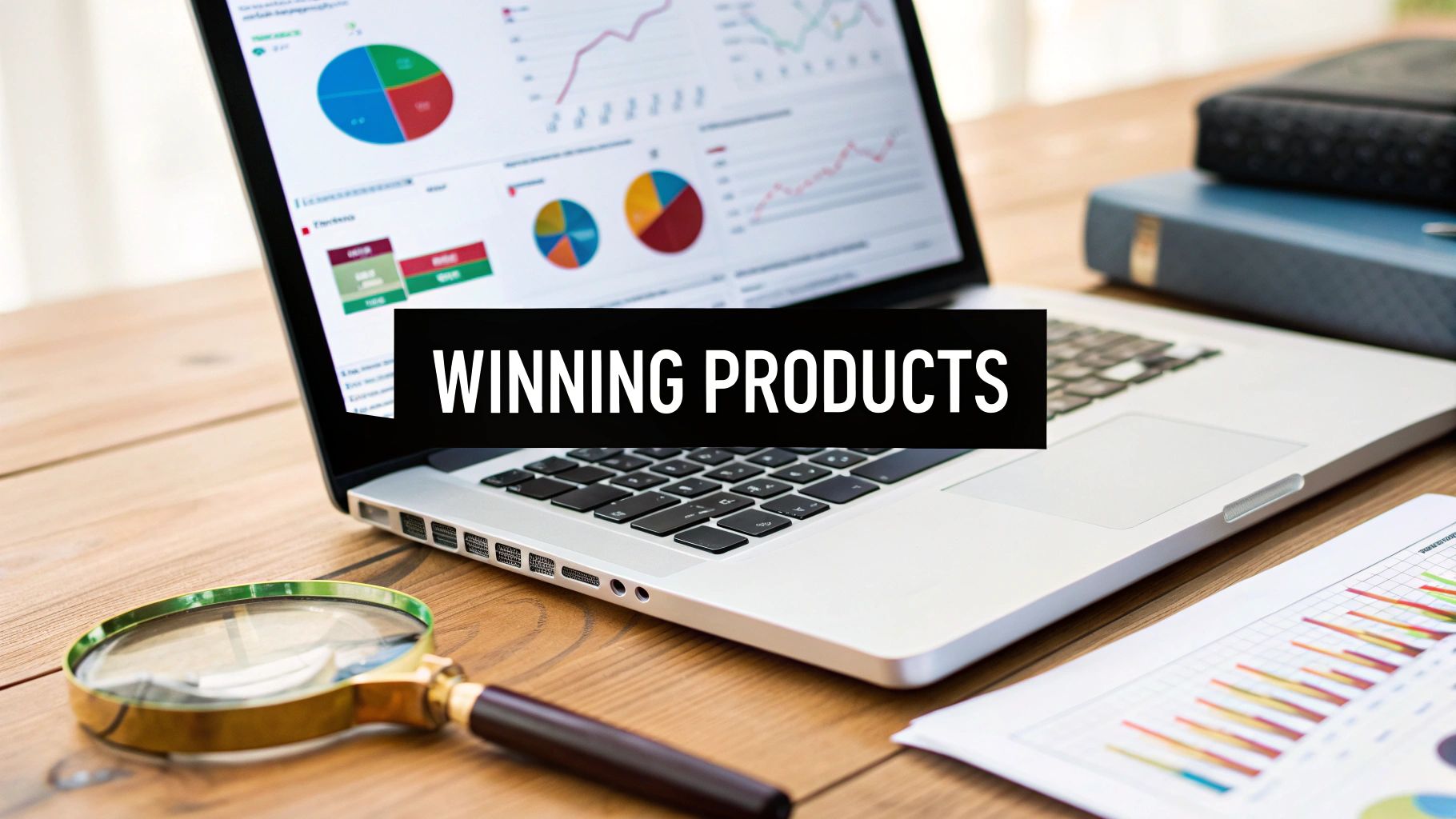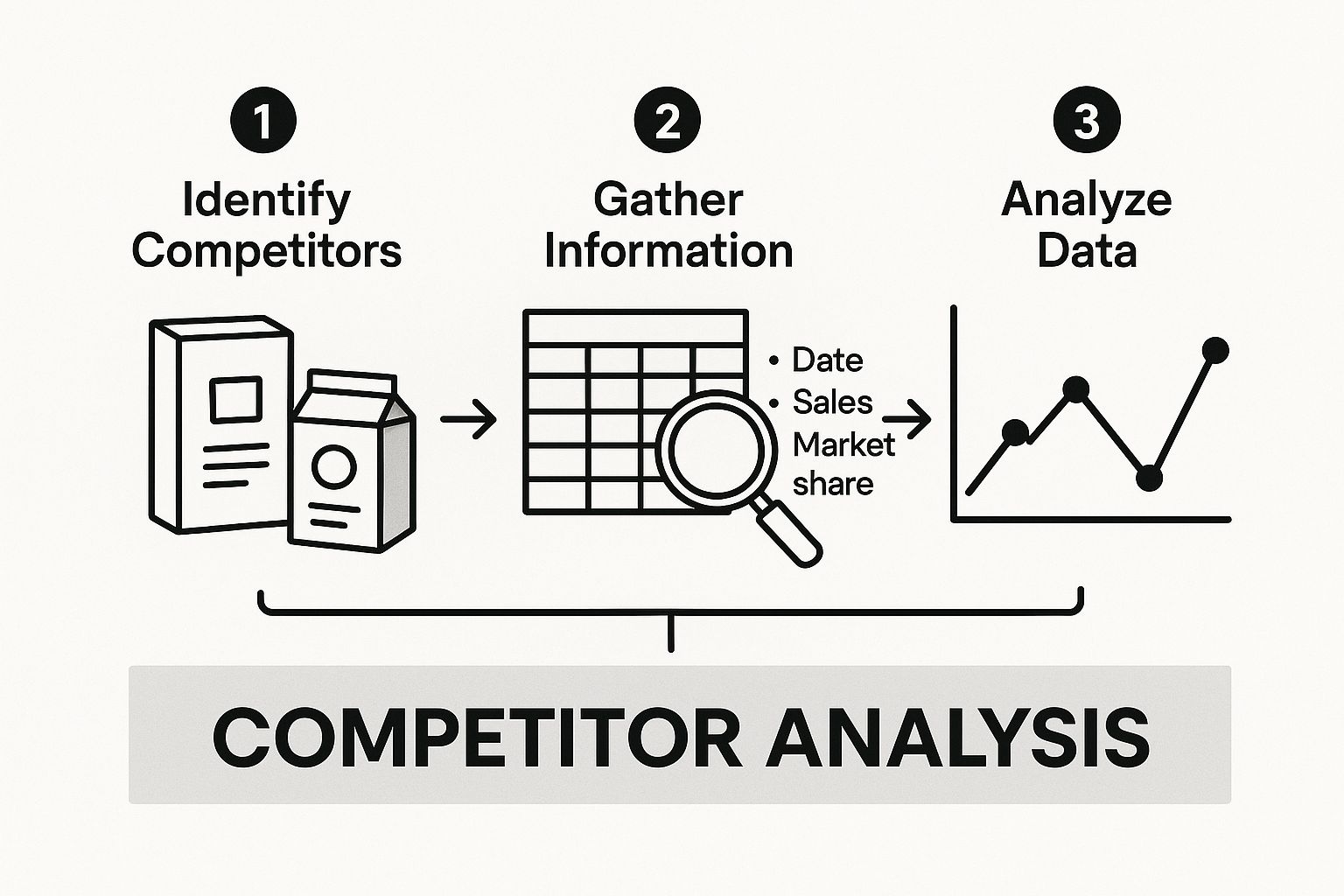Stay Updated with Everything about MDS
Thank you! Your submission has been received!
Oops! Something went wrong while submitting the form.

Chilat Doina
August 18, 2025
The secret to finding a winning product isn't some mystical art. It boils down to a pretty straightforward formula: find a real problem for a specific group of people in a market you actually understand.
Forget chasing the latest viral gadget. That's a short-term play. Real, sustainable e-commerce success is built on a solid foundation of genuine customer needs. It’s about turning the product-finding process from a wild guess into a repeatable strategy.

Before you even think about firing up a research tool or digging into trend reports, you need to lay the groundwork. This is the part that separates the flash-in-the-pan stores from the ones that thrive for years. The goal here is to stop thinking about just "selling stuff" and start thinking about solving problems for a select group of people.
It all starts with picking a niche that genuinely clicks with you—something you have a passion or expertise in. When you're into a market, you intuitively get the customers' frustrations and what they're looking for. This inside knowledge is your unfair advantage; it lets you spot opportunities that everyone else overlooks.
You can't sell to everybody. Instead, zero in on a single, specific "customer avatar." Get inside their head by asking some key questions:
Nailing this down helps you create a product that feels like it was made just for them. That’s how you get a sale and, more importantly, create a loyal fan from day one.
Chasing trends is a treadmill. It’s exhausting and rarely leads anywhere lasting. A truly winning product is a solution to a problem that won't go away. A huge piece of this is doing your homework upfront, which includes conducting competitive analysis to see where the gaps are. This is how you find pockets of the market that are being ignored.
So many product launches fizzle out because they don't solve a clear customer problem. In fact, a staggering 20% of new product launches miss their goals simply because there’s a mismatch with what the market actually wants. It’s a harsh reminder of why your product must solve a real problem.
The most successful products aren't just trendy; they are necessary. They fill a gap, soothe a pain point, or make a daily task significantly easier for a specific group of people. This is the core of a sustainable e-commerce business.
Ultimately, this whole stage is about deep thinking and smart planning. And if you're building this business from scratch, you have to think about your supply chain early on. Our guide on how to sell on Amazon from Alibaba is a great resource for navigating the sourcing side of things.
By locking in your niche, your customer, and the problem you're solving, you create a powerful filter. From now on, every product idea you have can be run through it.
Manual research has its place, but if you want a real edge, it's time to stop guessing and start making data-driven decisions. The right tools can feel like an unfair advantage, helping you spot what’s about to be huge, not what's already oversaturated. This is how you shift from hoping a product will sell to knowing it has a high probability of success.
Forget staring at best-seller lists. The real magic is using platforms like TikTok and Pinterest as forward-looking trend indicators. A quick search for hashtags like #tiktokmademebuyit or #amazonfinds can reveal products on the verge of exploding. You're looking for the patterns—items that pop up again and again with high engagement before they hit the mainstream.
While social media shows you emerging wants, tools like Semrush tell you what customers are actively searching for. This is absolutely critical for understanding the exact language people use when they're ready to pull out their wallets. By analyzing search volume and keyword difficulty, you can find those sweet spots—niches where demand is high but the competition hasn't caught on yet.
For example, you might see a spike in searches for "portable blender for travel." That’s way more specific and actionable than just "blenders." It tells you customers have a specific problem (making healthy drinks on the go) and are looking for a targeted solution. This is where opportunity lives.

Once you have a few promising ideas, it's time to go deep on the competition with specialized e-commerce tools like Helium 10. These platforms let you peek behind the curtain of successful Amazon listings. You can see a competitor’s estimated monthly revenue, their sales velocity, and even their historical pricing data.
This isn't about copying. It's about reverse-engineering their success to find their weaknesses.
With so many tools on the market, picking the right one can feel overwhelming. Your choice really depends on your budget and what you’re trying to accomplish—are you hunting for new trends, analyzing keywords, or spying on competitors?
Here’s a quick breakdown to help you decide.
Ultimately, the best tool is the one you'll actually use. Start with one that fits your immediate needs and budget, and you can always expand your toolkit as your business grows.
The goal of using research tools isn't just to gather data; it's to build a strong, evidence-based case for your product. Each data point should help you answer one critical question: "Why will customers choose my product over all other options?"
The demand for better insights is undeniable. The global product launch software market was valued at US$1.63 billion in 2023 and is expected to grow at an 11.2% CAGR through 2034, all driven by the need for better data.
To really get ahead of the curve, savvy sellers are now looking into predictive analytics for ecommerce to forecast market trends and consumer demand before they even happen. This is the next frontier of finding winning products.

Data tools are fantastic for spotting what is selling, but they rarely tell you why. The real magic—the stuff that builds a brand people actually care about—comes from listening to the unfiltered voices of real customers. This is where you uncover the frustrations, wishes, and desires that data alone will never show you.
Think of it as digital eavesdropping. Your mission is to be a fly on the wall where your target audience hangs out online. It’s less about spreadsheets and more about understanding human emotion and unmet needs.
Product reviews on sites like Amazon and Etsy are an absolute goldmine. But don't just skim the 5-star raves. The real opportunities are buried in the 2- and 3-star reviews. These are the people who wanted to love the product but were let down by a specific, nagging flaw.
Your job is to look for patterns in the complaints. When you see the same issue pop up over and over again, that’s not just a random problem—it's a market gap begging to be filled.
Every single one of these complaints is a blueprint for a better product. Your winning idea could be the one that finally fixes that "but."
A recurring complaint in a competitor's reviews is a direct request from the market for a better solution. Your job is to listen to that request and build the product they're asking for.
Beyond the big marketplaces, your future customers are already gathered in niche online communities. These are the places where they geek out over their passions, ask for advice, and—most importantly for you—complain about the gear they use.
Becoming a quiet observer in these groups is one of the most powerful research tactics you can use. I'm talking about forums, subreddits, and private Facebook groups all related to your niche.
r/dogs or niche Facebook groups for specific breeds. You'll see owners discussing everything from which "indestructible" chew toys their dog destroyed in five minutes to the nightmare of finding a good car seat cover that actually stays put.Pay attention to the exact language they use. The words and phrases they use to describe their problems are pure marketing gold. When you eventually launch your product, using their language in your copy will make your brand feel instantly familiar and trustworthy.
This is how you create a product that doesn't just solve a problem, but feels like it was made just for them.
A brilliant idea is just an idea until you can prove someone will actually pay for it. This is the stage where we separate the winners from the expensive duds. It's all about minimizing risk and dodging that soul-crushing mistake of ordering a container full of inventory that nobody wants.
You have to move from "I think this will sell" to "I know this will sell." That means getting real, hard feedback from potential customers—not just your supportive friends and family.
The great news? Validation doesn't have to drain your bank account. You can gather some seriously powerful data on your product’s viability before you ever cut a check to a supplier. The name of the game is testing the waters with small, smart experiments.
Before you even think about committing thousands of dollars, you need to see if there’s genuine market interest. We're not looking for polite compliments here. We need people to take an action that signals a real intent to buy.
Here are a few practical ways I've seen work time and time again:
Validation isn't just about getting people excited; it's about whether you can actually make money. A product everyone loves is still a business failure if the numbers don't work. You absolutely have to run the numbers to make sure your idea is financially sound.
First, figure out your potential profit margin. This means getting a solid estimate of your Cost of Goods Sold (COGS)—what you'll pay your supplier—and what you can realistically sell the product for. You need a healthy margin to cover marketing, shipping, and all the other little costs that pop up. As you get closer to sourcing, knowing the art of negotiating with suppliers can give those margins a healthy boost right from the start.
A product isn't truly "winning" until it proves it can be profitable. Customer interest is the first hurdle; a viable financial model is the finish line. Don't fall in love with an idea that can't make money.
Finally, get a rough estimate of your Customer Acquisition Cost (CAC). Look at the data from your test ad campaign. How much did it cost you to get one email subscriber or one pre-order? If your CAC is higher than the profit you'll make on a single sale, your business model is broken. These early tests are what give you the critical data you need to make a smart, informed decision on whether to push forward or go back to the drawing board.
You’ve pinpointed a winning product idea. That’s a huge milestone, but honestly, the real work is just getting started. Now you have to shift gears from research into execution, which boils down to two make-or-break phases: locking down a reliable supply chain and mapping out your product launch. This is the moment your idea starts becoming a real, tangible business.
Finding the right supplier isn’t just about getting the lowest price—it's about finding a true partner. A great supplier is the guardian of your quality, which has a direct line to your customer reviews and, ultimately, your brand's reputation. You want to look for partners who communicate clearly, give you straight answers on production timelines, and are willing to work with you on quality control.
Logistics can feel like a tangled mess, but if you break it down into smaller pieces, it’s completely manageable. Your core goals here are simple: nail the product quality and get it delivered without any major hiccups.
A well-oiled supply chain is your best defense against the classic headaches that plague new sellers, like surprise stockouts and a flood of quality complaints.
Nailing your product launch is a fantastic start, but it’s no guarantee of long-term success. The period right after you go live is absolutely crucial for turning that initial buzz into a sustainable brand. This is when you stop being a "seller" and start being an "optimizer."
The ultimate test of a winning product isn't the sales you make on launch day. It's your ability to keep the sales coming, rack up positive feedback, and adapt to what the market is telling you. That first wave of customers is handing you the most valuable data you'll ever get.
Long-term survival hinges on constantly monitoring your performance and making data-driven tweaks after you’re live. It’s a bit shocking, but studies show that almost two-thirds of new product launches are considered 'dead or dying' within two years. Why? Often, it’s because of a total lack of insightful performance tracking. You can dive deeper into why launches succeed or fail in this Kantar research.
This agile approach means you have to live inside your key performance indicators (KPIs)—things like sales velocity, conversion rates, and, most importantly, customer feedback. Are people raving about a specific feature? Are the same complaints popping up in your reviews? That feedback is your roadmap for future product improvements and marketing adjustments. Our guide on how to launch a new product gives you a detailed checklist to make sure you're set up for success right from the start. And don’t forget to keep a close eye on how your competitors react to your launch; that’s vital for staying one step ahead.
Even with the best research process, a few nagging questions always seem to surface. It’s that final stretch, where you’re trying to lock in a decision, that these common hurdles pop up. Let's tackle some of the most frequent what-ifs that trip up entrepreneurs on the hunt for their next bestseller.
Getting clear, practical answers is the only way to move forward with confidence instead of getting bogged down in analysis paralysis.
It's a total myth that you need to invent the next iPhone. The reality? Most winning products are just a better, smarter, or more focused version of something that already sells like crazy. Your unique edge doesn't have to be some groundbreaking new feature—it’s often much simpler than that.
You can carve out your own space by being different in ways that matter to a specific group of people:
Standing out isn’t about being revolutionary. It's about being more thoughtful and more targeted than everyone else in the game.
Don't fear competition; fear being irrelevant. A crowded market is just proof of massive demand. Your job isn't to find an empty stadium, but to become the fan favorite in a packed one.
Knowing when to fold ‘em is just as critical as knowing when to go all-in. Pouring your time, energy, and cash into a product with no real market pulse is one of the fastest ways to burn out.
It might be time to pull the plug if you’re seeing these red flags:
Cutting a losing idea loose isn't failure—it’s a strategic move. It frees up your resources and your focus to go find a real winner.
At Million Dollar Sellers, we've seen countless entrepreneurs wrestle with these exact questions. Our entire community is built on the idea that you can scale faster and smarter by learning directly from the wins (and losses) of other top-tier sellers. Stop guessing and start growing with insights from 7-, 8-, and 9-figure founders at milliondollarsellers.com.
Join the Ecom Entrepreneur Community for Vetted 7-9 Figure Ecommerce Founders
Learn MoreYou may also like:
Learn more about our special events!
Check Events